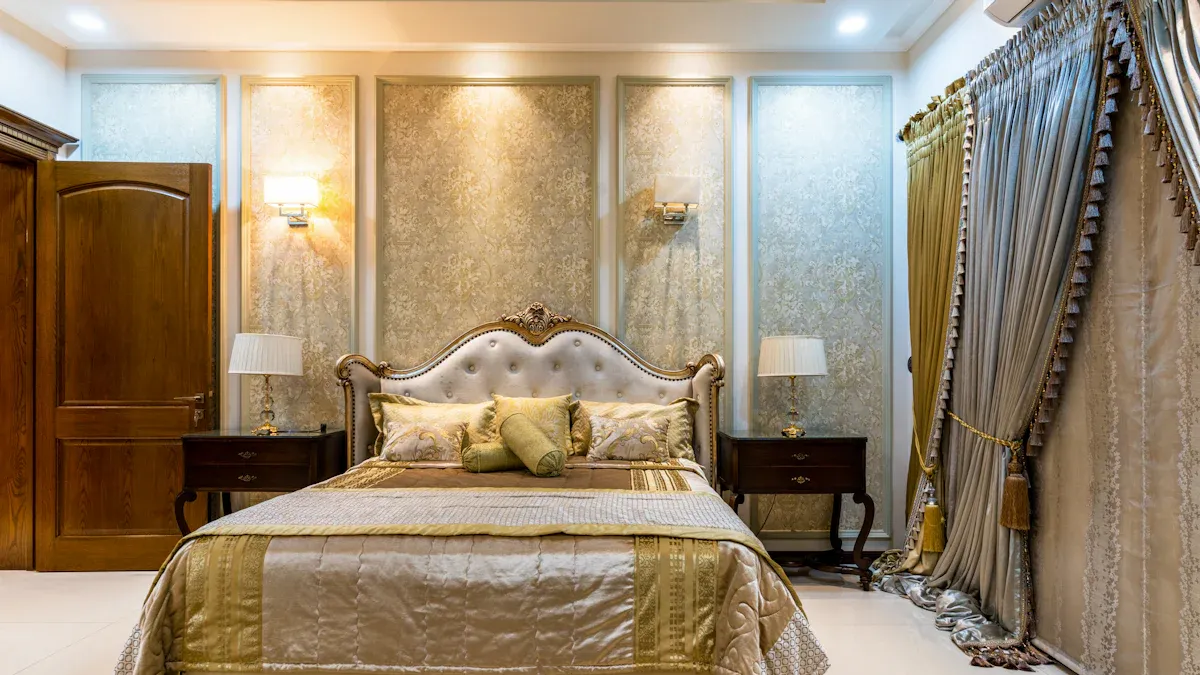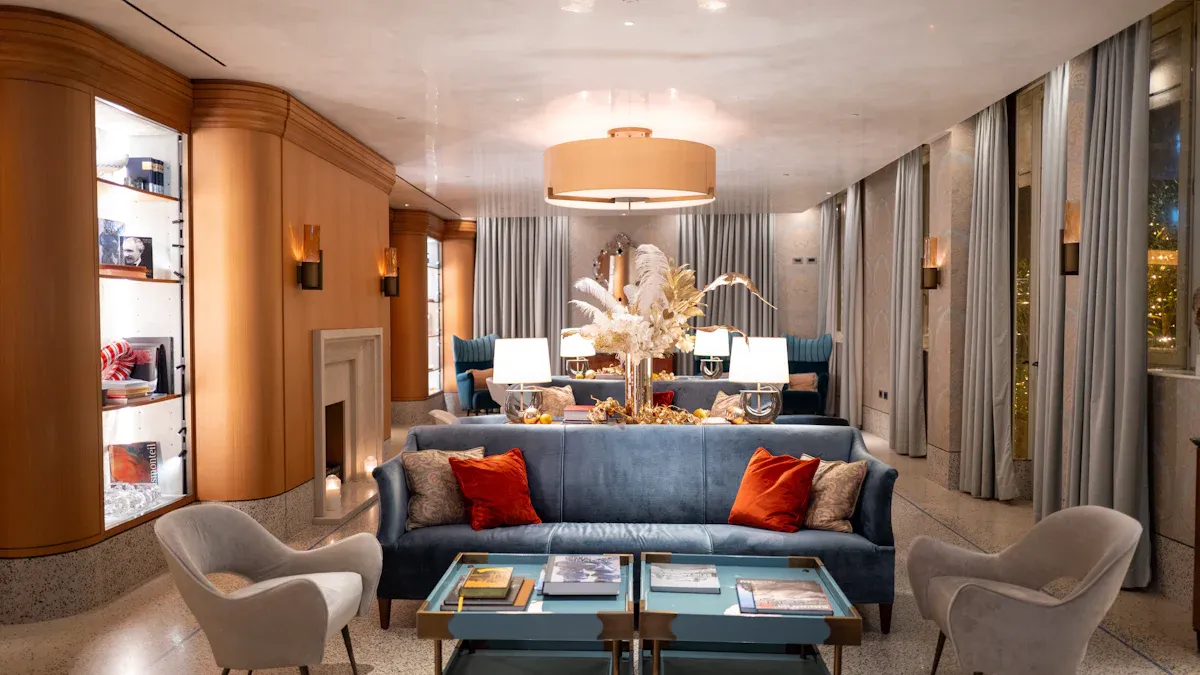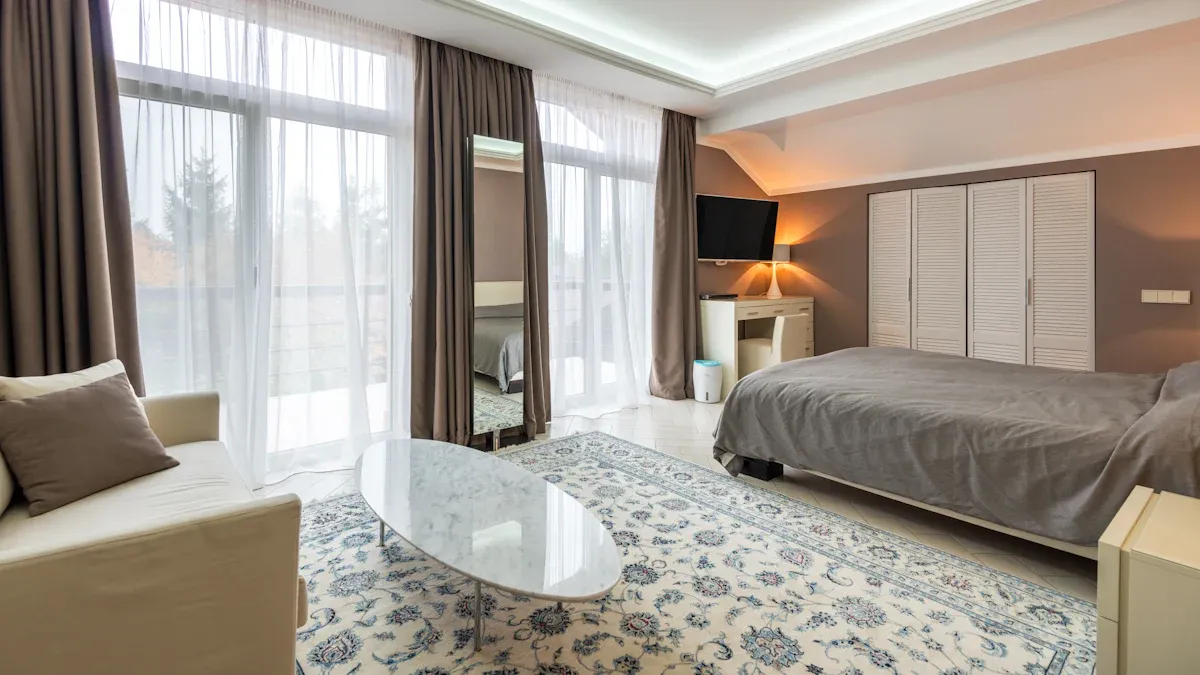
Customized hotel furniture is crucial for modern hospitality. Over 45% of procurement in upscale hospitality projects involves customized hotel furniture. Bespoke design profoundly shapes guest perception and brand identity. Curated scent environments enhance guest satisfaction, and strategic color choices establish brand recognition. Thoughtful customization prepares hotels for the future, offering a competitive edge.
Key Takeaways
- Custom hotel furniture helps hotels stand out. It makes guests feel special and comfortable.
- Choosing custom furniture involves planning. Hotels must define their vision, budget, and work with designers.
- Good custom furniture is durable and safe. It uses strong materials and meets fire safety rules.
The Strategic Advantage of Custom Hotel Furniture

Elevating Brand Identity
Custom furniture is essential for hotels to reflect their unique identity through design. Every curve, fabric, or finish tells the brand’s story and personality. This creates a strong visual identity across all spaces. For example, a boutique hotel inspired by local culture can incorporate regional materials and motifs into its furniture. This adds authenticity to the guest experience. Custom pieces prevent spaces from blending into the background. They ensure the hotel makes a lasting impression, strengthening brand recognition and fostering guest loyalty.
Enhancing Guest Experience
Custom designs significantly enhance the guest experience. They focus on ergonomic features like ideal seat depths and supportive cushioning. This ensures maximum comfort. Integrating regional materials or traditional patterns into furniture design creates an authentic sense of place. It connects guests to the destination’s heritage. Premium material selection offers tactile luxury and visual sophistication. This approach provides a welcoming, home-like experience for every guest.
Optimizing Space and Functionality
Custom hotel furniture offers smart solutions for space optimization. Multi-functional furniture, such as beds with built-in storage drawers or fold-out desks, maximizes room efficiency. Sofa beds can transform lounge areas into extra sleeping spaces. Wall-mounted tables fold away for flexibility. Utilizing vertical space with tall shelving units or wall-mounted systems also saves floor space. These strategies keep spaces clutter-free and highly functional.
Achieving Design Uniqueness
Custom furniture allows hotels to achieve unparalleled design uniqueness. Unlike generic, off-the-shelf options, custom pieces ensure a distinctive aesthetic. They prevent spaces from looking like every other hotel. This flexibility in material choices and design creates cohesive, memorable spaces. These spaces resonate with guests and reinforce the brand’s identity. Custom designs introduce an air of exclusivity, making the property more memorable and recommendable.
Navigating the Customization Process for Hotel Furniture
Creating custom hotel furniture involves a clear, step-by-step process. This journey ensures the final pieces perfectly match a hotel’s vision and operational needs. Understanding each stage helps hotels make informed decisions and achieve outstanding results.
Defining Vision and Requirements
The first step in any custom furniture project is to clearly define what you want. This means understanding the hotel’s brand and style. You need to think about your target guests, the atmosphere you want to create, and the overall design look. This helps guide all furniture choices. It ensures the furniture aligns with the hotel’s values and unique selling points. This creates a unified and memorable guest experience.
Next, you assess the functional requirements for each space. Different areas in a hotel, like guest rooms, the lobby, or the restaurant, have unique needs. Consider comfort, how long the furniture will last, how easy it is to clean, and how well it resists daily wear. These considerations ensure the furniture performs well in busy areas while still looking luxurious.
Budgeting for Bespoke Pieces
Budgeting for custom pieces requires careful planning. Bespoke items often cost more than off-the-shelf options due to unique design, specialized materials, and skilled craftsmanship. Hotels must allocate funds for design fees, material costs, manufacturing, and shipping. It is wise to include a contingency fund for unexpected changes or challenges. A clear budget helps manage expectations and ensures the project stays on track financially.
Design and Prototyping Stages
After defining the vision, the design and prototyping stages begin. This starts with brainstorming and conceptualizing ideas. Designers discuss the hotel’s brand identity and values. They then translate these ideas into initial design sketches. This phase also includes creating photorealistic 3D renderings. These visuals help everyone see how the furniture will look in the space.
Next comes design refinement. Designers turn conceptual ideas into practical plans. They work closely with the hotel, getting feedback and making changes until the design is perfect. During this time, they also select materials. They consider durability, how the materials look, and if they are sustainable. This ensures the furniture creates a luxurious environment.
Finally, prototyping takes place. A full-scale master version of the approved design is created. This allows clients to physically interact with the furniture. They can evaluate its comfort, finish, and overall quality. This step helps eliminate risks and ensures perfection before full production begins. Any necessary revisions are made based on specific client needs or overlooked details.
Manufacturing and Quality Control
Manufacturing custom hotel furniture involves strict quality control measures. This ensures every piece meets high standards. First, material selection and inspection are crucial. Workers rigorously inspect all components before production. They check wood for warping or cracks. They examine upholstery fabrics for fire-retardancy and stain resistance. Metal hardware is checked for corrosion resistance. Surface finishes are inspected for scratch, moisture, and fade resistance.
Next, manufacturing process oversight ensures consistency and minimizes defects. This includes precision cutting and assembly. It also involves seamless finishing with uniform coatings. Reinforced joinery and fastening are also key.
Durability and performance testing follow. Furniture must meet industry standards for strength and longevity. This includes weight-bearing tests and impact resistance tests. They also perform cycle testing for moving parts, abrasion and scratch resistance, and humidity and moisture resistance.
Safety and compliance checks are also paramount. This involves fire safety compliance for upholstered furniture. It also includes chemical safety for non-toxic materials. Stability tests prevent tipping. Designers also consider child and elderly safety, such as rounded edges.
Finally, aesthetic and finishing inspections ensure the furniture looks perfect. Inspectors verify color and texture consistency. They check for flawless finishing without bubbles or scratches. Upholstery integrity with even stitching is also important. They ensure seamless assembly and smooth functionality of drawers and doors.
Material Selection for 2025 Hotel Furniture
Choosing the right materials for hotel furniture is a critical decision. It impacts sustainability, durability, aesthetics, and ease of care. Hotels must select materials that align with their brand and operational needs.
Sustainable and Eco-Friendly Options
Hotels increasingly prioritize eco-friendly choices. They look for materials that reduce environmental impact. Certified solid wood, sourced from responsibly managed forests, is a top choice. Bamboo, a fast-growing resource, also offers natural antimicrobial properties. Recycled metals like aluminum and steel minimize the need for new mining. Designers also use recycled and bioplastic materials, some even biodegradable. Eco-friendly textiles, such as organic cotton or recycled polyester, often feature natural dyes. Innovative materials like mycelium (fungus-based) and recycled ocean plastics are also gaining traction. These choices help hotels reduce their carbon footprint.
Durability and Longevity
High-traffic hotel environments demand robust materials. Metal mouldings, especially stainless steel, offer superior durability. They resist dents, scratches, and corrosion. Brass and bronze are also strong, and they develop a beautiful patina over time. High-quality hardwoods like teak and oak provide excellent longevity with proper care. Bamboo also boasts impressive tensile strength. For upholstery, commercial-grade leather and performance microfiber resist wear effectively. Stone surfaces, such as marble, withstand impacts and scratches, making them ideal for tabletops. Tempered glass tabletops offer easy cleaning and damage resistance.
Aesthetic Appeal and Texture
Aesthetic trends for 2025 focus on unique designs and rich textures. Hotels seek personalized pieces, often using locally sourced or reclaimed materials. This includes handwoven textiles and natural stone accents. Bold and playful aesthetics are popular, featuring statement pieces and color blocking. Designers also emphasize wellness and comfort, creating a home-away-from-home feel. Plush, tailored furniture with high-end fabrics like performance velvet and leather are common. Jewel tones, such as deep greens and rich golds, combine with warm earthy tones. Layering textures like silks, velvets, and linens creates an opulent atmosphere. Mid-century modern and nature-inspired interiors also remain strong trends.
Maintenance and Cleaning
Easy maintenance is crucial for busy hotels. Regular dusting and immediate spill cleanup are general best practices. For upholstery, weekly vacuuming and professional deep cleaning every few months are recommended. Wooden furniture benefits from regular polishing and protective coasters. Metal pieces need wiping with a damp cloth and rust-resistant coatings, especially outdoors. Mattresses require rotating and flipping every 3-6 months, along with mattress protectors. Stone surfaces need mild soap solutions and periodic resealing. For fabric and vinyl, a simple warm soap and water solution often works for spills.
Key Design Trends for 2025 Hotel Furniture

Hotels constantly look for new ways to impress guests. They want to create memorable stays. The design of hotel furniture plays a big role in this. Several key trends will shape hotel interiors in 2025. These trends focus on guest well-being, smart functionality, and unique aesthetics.
Biophilic Design Integration
Biophilic design brings the natural world indoors. It connects guests with nature. This trend uses natural materials like wood and stone. It also includes living plants and natural light. Designers might use patterns and textures found in nature. This approach creates a calming and refreshing atmosphere. Guests feel more relaxed and at ease. It helps reduce stress and improves overall well-being. Hotels use biophilic elements to make spaces feel more vibrant and alive.
Multifunctional Solutions
Modern hotel rooms often have limited space. Multifunctional furniture offers smart solutions. These pieces serve more than one purpose. They help maximize room efficiency. For example, sofa beds with hidden storage combine seating, sleeping, and storage. Guests can store luggage or linens easily. Foldable desks and wall-mounted tables provide workspace. Guests can fold them away to keep floors clear. Modular seating options are also popular. Sectional sofas can be rearranged to create open spaces. They can also accommodate groups. Stackable or nesting chairs save space. Smart furniture also integrates technology. It includes built-in charging stations and smart lighting. Adjustable beds enhance convenience for tech-savvy travelers. These solutions make modern hotel rooms more efficient and guest-friendly.
Smart Technology Integration
Technology makes hotel furniture more convenient and modern. Guests expect easy access to power and connectivity. Hotel furniture now includes many smart features. Built-in USB ports and charging stations are common. Guests can charge their devices easily. Charging ports and data access points are often in headboards and desks. Smart desks offer wireless connectivity. Smart beds can have adjustable firmness and temperature control. LED lighting elements create different moods. Bluetooth speakers allow guests to enjoy their music. Some bedside stands even have pull-out platforms for device charging. These integrations enhance the guest experience. They make stays more comfortable and convenient.
Personalized Guest Comfort
Guests want unique experiences. They do not want uniform interiors. Personalized furniture design helps hotels stand out. Modular furniture allows guests to arrange or adjust furnishings. This creates a personalized space for relaxation or work. Hotels can also refresh room layouts easily. They can match trends or seasonal changes without major renovations. Custom hotel furniture helps create a distinct and memorable experience. This builds guest loyalty and repeat business. It allows hotels to tailor spaces to specific guest needs. This enhances comfort and functionality. Investing in custom pieces shows a commitment to guest satisfaction. It provides unique designs and a visually stunning environment. Hotels can align their interiors with their brand concept. This could be luxury, eco-friendly, or minimalist. Incorporating traditional design elements also adds cultural relevance. This improves guest satisfaction.
Artisanal and Handcrafted Elements
Artisanal and handcrafted elements add character to hotel spaces. Each piece is unique. No two are exactly alike. They show the artisan’s personality and skill. This offers authenticity. Mass-produced items cannot match this. These pieces often use sustainable materials. Examples include reclaimed wood or recycled metal. They are also designed for durability. This reduces waste. Craftsmanship ensures pieces last for generations. This minimizes the need for frequent replacements. Handcrafted items support local economies and traditional crafts. They add warmth, texture, and depth to a space. They often feature hand-carved details or intricate inlays. Natural materials like wood, leather, and metal are common. Hotels might use woven armchairs in lobbies. They might also have mid-century rattan side tables. Local artisans often make these. Low benches and footrests provide texture in social areas. Hotels can avoid overproduction by using on-demand production. They can also use certified woods and renewable fibers. Some hotels even recognize artisans with a small plaque on each piece. They also share design trends with artisans. Artisans share ancestral techniques with hotel design teams.
Ensuring Durability and Safety in Hotel Furniture
Hotels must prioritize durability and safety in their furniture choices. This protects guests and ensures long-lasting investments. Thoughtful material selection and design prevent accidents and reduce maintenance costs.
Fire Retardant Materials
Fire safety is a top concern for hotels. Furniture must meet strict fire retardancy standards. In the U.S., many hotel chains like Hilton and Marriott reference California Technical Bulletin 117 (Cal 117). NFPA 260 is another primary reference for cigarette ignition resistance. The Upholstered Furniture Action Council (UFAC) also provides the UFAC CLASS 1 standard. Internationally, regulations vary. The UK uses Furniture and Furnishings (Fire Safety) Regulations (FFRS) and BS 5852 (Crib5). Germany has DIN 4102, and France uses NF P. 92.507, though European standards like EN 13-501-1 are now common. Designers need to know these diverse standards for global compliance.
Moisture and Stain Resistance
Hotel furniture faces constant spills and heavy use. Materials with excellent moisture and stain resistance are essential. Crypton fabrics offer an impenetrable moisture barrier; liquids bead up on the surface. They also have built-in stain and odor resistance. Inside Out Fabrics are inherently liquid and stain resistant, and you can clean them with bleach. Indoor-Outdoor fabrics repel water and resist soil and mildew. Microfiber is also known for its stain resistance. These materials help keep furniture looking new and reduce cleaning efforts.
Structural Integrity and Wear
Furniture in hotels must withstand heavy use. Structural integrity and wear resistance are crucial. Solid hardwoods like oak are better than MDF for longevity. Stainless steel frames resist rust, and aluminum is lightweight. For upholstery, leather and stain-resistant fabrics work well in high-traffic areas. Cushions need a minimum foam density of 1.8 lbs/ft³ for durability. Check for joint reinforcements like metal brackets and quality screws. Certifications like ASTM F2057-19 test for tip-over risks. BIFMA X5.5-2017 covers strength and safety for commercial sofas. Anti-tip devices on tall cabinets also add safety.
Ergonomics and Guest Comfort
Ergonomic design makes guests feel comfortable and supported. Furniture should provide proper support, reducing strain. It needs to be functional, supporting guest activities. Designs should also adapt to various guest preferences and needs. This includes comfortable mattresses with balanced support and adjustable headboards. Desk chairs should offer lumbar support. Lounge chairs often have adjustable seat height and backrests. Desks need appropriate height and good lighting. These features ensure guests maintain a healthy posture and enjoy their stay.
Selecting Your Custom Hotel Furniture Partner
Choosing the right partner for custom hotel furniture is a big decision. This partner helps bring your vision to life. They ensure your furniture meets high standards.
Evaluating Experience and Portfolio
Start by looking at a potential partner’s experience. Review their portfolio for work with luxury hotels or high-end clients. Look for case studies that match your hotel’s style. Client testimonials show a manufacturer’s ability to deliver quality products on time. They also show how a partner handles complex projects. Verify their ability to create custom pieces that match your design vision. Ask about their material sourcing and sustainability standards. Check their production capacity to meet deadlines without lowering quality. Finally, ensure their offerings align with your budget.
Assessing Communication and Collaboration
A reliable partner communicates clearly. They anticipate and share any obstacles. They interact at key project milestones, offering input and progress feedback. They also share detailed shop drawings for your review before manufacturing begins. These drawings show item appearance, materials, and other important details. A good partner acts as a true collaborator from start to finish. They answer questions and help with unexpected challenges. They also practice transparent communication and show flexibility when adjusting orders or designs.
Understanding Production Capabilities
A strong partner has excellent production capabilities. Quality control is essential in their production line. They have strict measures at every manufacturing stage. This guarantees all furniture aspects meet high standards. From material selection to assembly and finishing, each step gets careful attention. This upholds the durability, function, and look of your custom hotel furniture. They use advanced technology and expert craftsmanship. This ensures their furniture surpasses industry standards. They also pay meticulous attention to detail, striving for perfection in every stitch and joint.
Post-Installation Support and Warranty
After installation, a good partner offers ongoing support. They help with immediate concerns, troubleshoot issues, and make necessary adjustments. They also provide important documents like manuals and care instructions. Some even offer staff training on how to care for the new furniture. Look for a comprehensive warranty, like a 10-year warranty for all hotel furniture. Some partners also offer a year of maintenance support after the project finishes.
Strategic customization offers lasting value for hotels. It future-proofs properties with thoughtful design choices for their hotel furniture. Embracing bespoke solutions gives a competitive edge in the market. Hotels create unique, memorable experiences for guests. This ensures long-term success and builds strong guest loyalty.
FAQ
What is custom hotel furniture?
Custom hotel furniture is unique. Manufacturers design and build it specifically for a hotel. It matches the hotel’s brand and space perfectly.
Why should hotels choose custom furniture?
Custom furniture elevates brand identity. It enhances guest comfort. It also optimizes space. This creates a unique and memorable experience for guests.
How does custom furniture support sustainability?
Hotels can choose eco-friendly materials. They can also design durable pieces. This reduces waste. It supports responsible sourcing practices.
Post time: Oct-20-2025




